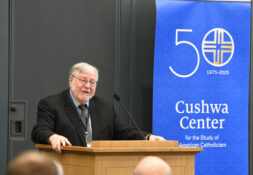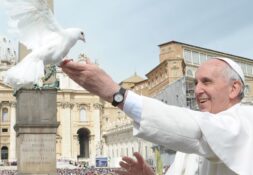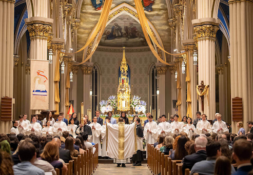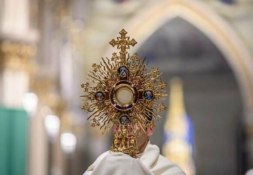The good news that Brother André Bessette, C.S.C. (1845-1937) was canonized in Rome on 17 October 2010 brought great joy to the Church in Canada and to the campus of Notre Dame, which St. André visited twice. The glad tidings remind all that Brother André dedicated his apostolate to spreading knowledge and love of St. Joseph well beyond Canada, indeed throughout the world.
The question arises: why devotion to St. Joseph? How can this emphatic attention to St. Joseph find any basis in Scripture or Tradition? Scripture itself provides a useful key. St. Joseph figures only in the infancy narratives of Matthew and Luke. In neither Gospel does Joseph pronounce a single sentence. His role, in point of fact, demands the towering example of silent faith and prompt obedience in the face of great mystery. He too played a pivotal yet humble part in the great mystery of the Redemption.
Matthew, addressing a Hebrew congregation, sketches the character and personality of St Joseph in higher relief than does Luke. After presenting the genealogy of Joseph (Mt 1:1-17), Matthew records the circumstances surrounding the birth of Jesus Christ:
When his mother Mary had been betrothed to Joseph, before they came together she was found to be with child of the Holy Spirit; and her husband Joseph, being a just man and unwilling to put her to shame, resolved to send her away quietly. (Mt 1:18-19)
The evangelist records that Mary was found to be “with child of the Holy Spirit.” He describes St Joseph as “a just man.” Were Mary simply to have been found with child, Joseph, would have been obliged to denounce her to the authorities and let justice takes its course. But Matthew states that Mary was found to be with child “of the Holy Spirit.”
This fact plays a pivotal role in the response of Joseph. St Joseph’s hesitation resembles the reluctance of King David to have the Ark of the Covenant brought near to him. An Israelite named Uzzah, not of the tribe of Levi, had died suddenly for daring to touch the ark in order to prevent it falling off a cart en route to Jerusalem (2 Sam 6:2-17). Aware of his own unworthiness, David left the ark in the field of Obededom the Gittite, until it became clear that the ark would not destroy the king. Matthew’s Joseph, revering the mystery of the Lord’s Incarnation, may well have intuited the dignity of Mary as the new, living Ark of the Covenant.
Yet the Gospel of Matthew draws a discreet curtain across many of the personal details of the just man Joseph. What does emerge from the pages of Matthew is the portrait of a man who resembles his Old Testament namesake, the patriarch Joseph (Gen 30:25; 37; 39-50). Just as God had spoken to the patriarch Joseph in dreams, so the angel of the Lord communicated with Joseph of Nazareth by means of dreams. When Joseph of Nazareth considered sending away the Virgin Mary,
Behold, an angel of the Lord appeared to him in a dream, saying, ‘Joseph, son of David, do not fear to take Mary your wife, for that which is conceived in her is of the Holy Spirit; she will bear a son, and you shall call his name Jesus, for he will save his people from their sins. (Mt 1:20)
Joseph’s response is immediate and unquestioning:
When Joseph woke from sleep, he did as the angel of the Lord commanded him; he took his wife, but knew her not until she had borne a son; and he called his name Jesus. (Mt 1:24-25)
Joseph obeys the command of the angel and lives in chaste intimacy with Mary. In this respect, Joseph of Nazareth resembles the patriarch Joseph, who maintained his own moral probity and good character in the house of Potiphar, captain of the guard (Gen 39). When Potiphar’s wife made lewd advances toward Joseph, he resisted them. The patriarch’s fidelity therefore found favour with God: “the Lord was with him; and whatever he did, the Lord made it prosper” (Gen 39:23). This is altogether fitting, since the Hebrew name Joseph means “increase.”
In obedience to the divine mandate and to the Mosaic Law, Joseph of Nazareth gives Jesus his name on the eighth day after the birth of the child. Although the account of the visit of the Magi mentions Mary, it makes no allusion to Joseph. Only after the Magi depart from Bethlehem, does Joseph reemerge in the accounts of Jesus’ infancy. In obedience to another dream, Joseph takes the Infant Jesus and his mother Mary into Egypt to escape the fury of Herod, who seeks the life of the child (Mt 2:13-15). Again, Joseph, upon waking, does exactly what he is told.
By bringing Christ to Egypt, Joseph of Nazareth imitates his namesake yet again. For Joseph the patriarch, having interpreted a dream of Pharaoh, urged the king to store up wheat during seven years of plenty in order to withstand the following seven years of famine. By the time of famine, Joseph, now viceroy of Egypt, had saved sufficient wheat to feed both the house of Egypt and the house of Israel in the person of his own brothers and their families. When the Egyptians had approached Pharaoh for food, the king told them: “Go to Joseph; what he says to you, do” (Gen 41:55). Joseph, then, supplied both Egypt and Israel with their bread. The Patriarch Joseph, brought to Egypt by divine Providence, advised Pharaoh to store up seven years’ worth of wheat, thereby arranging the means later to feed both the houses of Egypt and of Israel. Pharaoh made that Joseph his viceroy, commanding the people: “Go to Joseph and do whatever he tells you!” (Gen 41:55.) By taking the Christ Child into Egypt and by restoring him to Galilee after the death of Herod, Joseph of Nazareth had preserved, for both Jew and Gentile, the Bread of Life (see Jn 6:35, 48). The Church owes thanks to the Blessed Virgin Mary for having borne the Bread of Life in the House of Bread (Bethlehem), but the Church owes thanks also to St Joseph for having preserved the Bread of Life from danger by the flight into Egypt and by the return to Galilee after the danger had subsided.
St Joseph helps the Church not only by his example. The Church invokes the aid of his prayers both in the sacred liturgy and in popular devotion. As mentioned earlier, Blessed Pope Pius IX in 1870 placed the Church under the patronage of St Joseph, thereby echoing the ancient admonition of Pharaoh, “Go to Joseph!” On the solemnity of St Joseph (19 March), therefore, and on the memorial of St Joseph the Worker (1 May), the Church asks the help of his prayers in continuing to serve the Lord Jesus with fidelity. In 1962, Blessed John XXIII inserted St Joseph’s name in the Roman Canon (Eucharistic Prayer I). The Litany of St Joseph remains one of the five litanies approved for public recitation.
St Joseph stands as a model of humility and obedience to the design of Providence. He teaches members of the Church reverence in the face of mystery, patience in adversity, and the value of silence in the interior life. As patron of husbands and fathers, consecrated religious, carpenters, artisans, workers, the unemployed, migrants and homeowners, the sick and the dying St Joseph intercedes for a wide constituency. This is particularly so in view of his patronage of the universal Church. For students and scholars, likewise, this silent saint offers the key to contentment, which lies in fulfilling their duties and in making the object of their attention and affection the Person of Christ, who identified himself as “the way, the truth, and the life” (Jn 14:6).
Fr Neil J. Roy, STL, PhD, teaches in the Dept of Theology. His edition of Benedict Xvi and the Sacred Liturgy is appearing in paperback in March 2011. A fuller version of this article will appear in the March 2011 issue of Catholic Insight.





